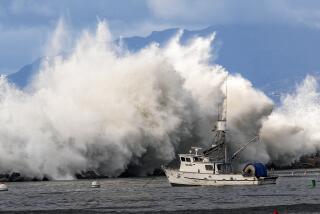Congress Told of Threat Posed by El Nino
- Share via
WASHINGTON — In the latest warnings about El Nino, members of Congress were confronted on Thursday with dire predictions of potentially heavy flooding and destructive landslides induced by the weather phenomenon in portions of Southern California.
A panel of scientists, meteorologists and emergency planning officials appeared before a House subcommittee hearing that focused largely on problems of water management and water conservation that could occur if El Nino produces its anticipated heavy rains.
Flooding associated with El Nino could seriously affect water quality because “increased loads of nutrients and toxic chemicals may be washed into rivers during flood conditions,” said Dr. Mark Schaefer, acting director of the U.S. Geological Survey.
Schaefer also said that there was “a high landslide potential” caused by the threat of increased rainfall along the coast, and that the hazard could extend into next year.
Stephen K. Hall, executive director of the Assn. of California Water Agencies, testified that El Nino could “play havoc on a water system already stressed to the breaking point.”
Hall, whose nonprofit organization represents 440 public water agencies, said his members struggle in normal times to balance flood control and water supply needs. But El Nino threatens to put added tension on a system “built decades ago before modern construction techniques were available,” he said.
Hall explained that “water managers must keep enough reservoir storage space available to manage floods during heavy precipitation, while ensuring that adequate water is stored to meet water supply needs for cities and farms to protect against drought.”
*
Rep. John T. Doolittle (R-Rocklin), chairman of the water and power subcommittee of the House Resources Committee, said federal officials must play a primary role in coordinating efforts to prepare for El Nino’s effects, and to protect the quality and quantity of drinking water.
The subcommittee hearing followed a warning last week from the Federal Emergency Management Agency that a vast swath of the Los Angeles Basin is at risk of being swamped unless the region’s flood control system is improved.
Another of Thursday’s witnesses, Richard Andrews, director of the California Office of Emergency Services, said even though specific forecasts remain uncertain, the state can expect “substantially more rainfall than normal” this fall and winter.
“Some forecasts suggest that the storms may come as early as November and, if the initial rains are sufficient to soak the ground, we could have an early and long flood season,” Andrews said.
Some scientists cautioned the subcommittee, however, that efforts to predict the effects of El Nino are fraught with uncertainty.
*
“The past 15 years have witnessed remarkable advances in the observations, understanding and predictions of climate variability,” said Elbert W. Friday, an official of the National Oceanic and Atmospheric Administration.
“At the same time, it is important to keep in mind that the science of climate prediction is still in its infancy,” he said. “Climate predictions are by their nature probability forecasts.”
Local preparedness meetings have been held recently in California to acquaint residents with the threat of El Nino.
Two weeks ago, for example, Vice President Al Gore presided at an El Nino Community Preparedness Summit in the Santa Monica Civic Auditorium at which an official of the National Oceanographic and Atmospheric Administration described the threat.
More to Read
Sign up for Essential California
The most important California stories and recommendations in your inbox every morning.
You may occasionally receive promotional content from the Los Angeles Times.










